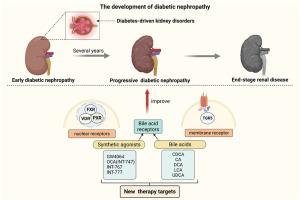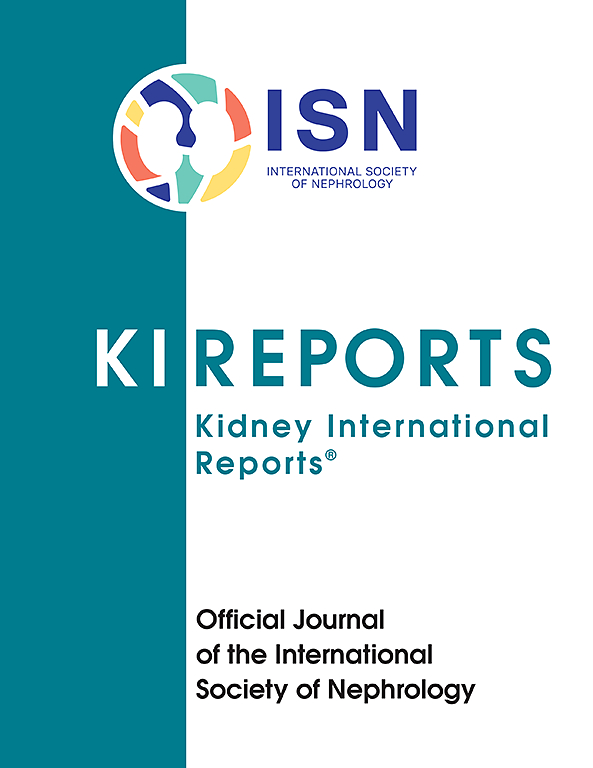Role of Bile Acid Receptors in the Development and Function of Diabetic Nephropathy
IF 5.7
2区 医学
Q1 UROLOGY & NEPHROLOGY
引用次数: 0
Abstract
Diabetic nephropathy (DN) is a prevalent microvascular complication that occurs often in individuals with diabetes. It significantly raises the mortality rate of affected patients. Therefore, there is an urgent need to identify therapeutic targets for controlling and preventing the occurrence and development of DN. Bile acids (BAs) are now recognized as intricate metabolic integrators and signaling molecules. The activation of BAs has great promise as a therapeutic approach for preventing DN, renal damage caused by obesity, and nephrosclerosis. The nuclear receptors (NRs), farnesoid X receptor (FXR), pregnane X receptor (PXR), vitamin D receptor (VDR); and the G protein-coupled BA receptor, Takeda G-protein-coupled receptor 5 (TGR5) have important functions in controlling lipid, glucose, and energy metabolism, inflammation, as well as drug metabolism and detoxification. Over the past 10 years, there has been advancement in comprehending the biology and processes of BA receptors in the kidney, as well as in the creation of targeted BA receptor agonists. In this review, we discuss the role of BA receptors, FXR, PXR, VDR, and TGR5 in DN and their role in renal physiology, as well as the development and application of agonists that activate BA receptors for the treatment of kidney diseases.

胆汁酸受体在糖尿病肾病的发展和功能中的作用
糖尿病肾病(DN)是一种常见的微血管并发症,经常发生在糖尿病患者身上。它大大提高了患者的死亡率。因此,亟需确定治疗靶点,以控制和预防糖尿病肾病的发生和发展。胆汁酸(BAs)是目前公认的复杂的代谢整合因子和信号分子。激活胆汁酸有望成为预防 DN、肥胖引起的肾损伤和肾硬化的治疗方法。核受体(NRs)、类法尼斯 X 受体(FXR)、孕烷 X 受体(PXR)、维生素 D 受体(VDR)和 G 蛋白偶联 BA 受体武田 G 蛋白偶联受体 5(TGR5)在控制脂质、葡萄糖和能量代谢、炎症以及药物代谢和解毒方面具有重要功能。在过去的 10 年中,人们在理解肾脏中 BA 受体的生物学特性和过程方面取得了进展,同时也在创造有针对性的 BA 受体激动剂方面取得了进展。在这篇综述中,我们将讨论 BA 受体、FXR、PXR、VDR 和 TGR5 在 DN 中的作用及其在肾脏生理中的作用,以及开发和应用激活 BA 受体的激动剂来治疗肾脏疾病。
本文章由计算机程序翻译,如有差异,请以英文原文为准。
求助全文
约1分钟内获得全文
求助全文
来源期刊

Kidney International Reports
Medicine-Nephrology
CiteScore
7.70
自引率
3.30%
发文量
1578
审稿时长
8 weeks
期刊介绍:
Kidney International Reports, an official journal of the International Society of Nephrology, is a peer-reviewed, open access journal devoted to the publication of leading research and developments related to kidney disease. With the primary aim of contributing to improved care of patients with kidney disease, the journal will publish original clinical and select translational articles and educational content related to the pathogenesis, evaluation and management of acute and chronic kidney disease, end stage renal disease (including transplantation), acid-base, fluid and electrolyte disturbances and hypertension. Of particular interest are submissions related to clinical trials, epidemiology, systematic reviews (including meta-analyses) and outcomes research. The journal will also provide a platform for wider dissemination of national and regional guidelines as well as consensus meeting reports.
 求助内容:
求助内容: 应助结果提醒方式:
应助结果提醒方式:


